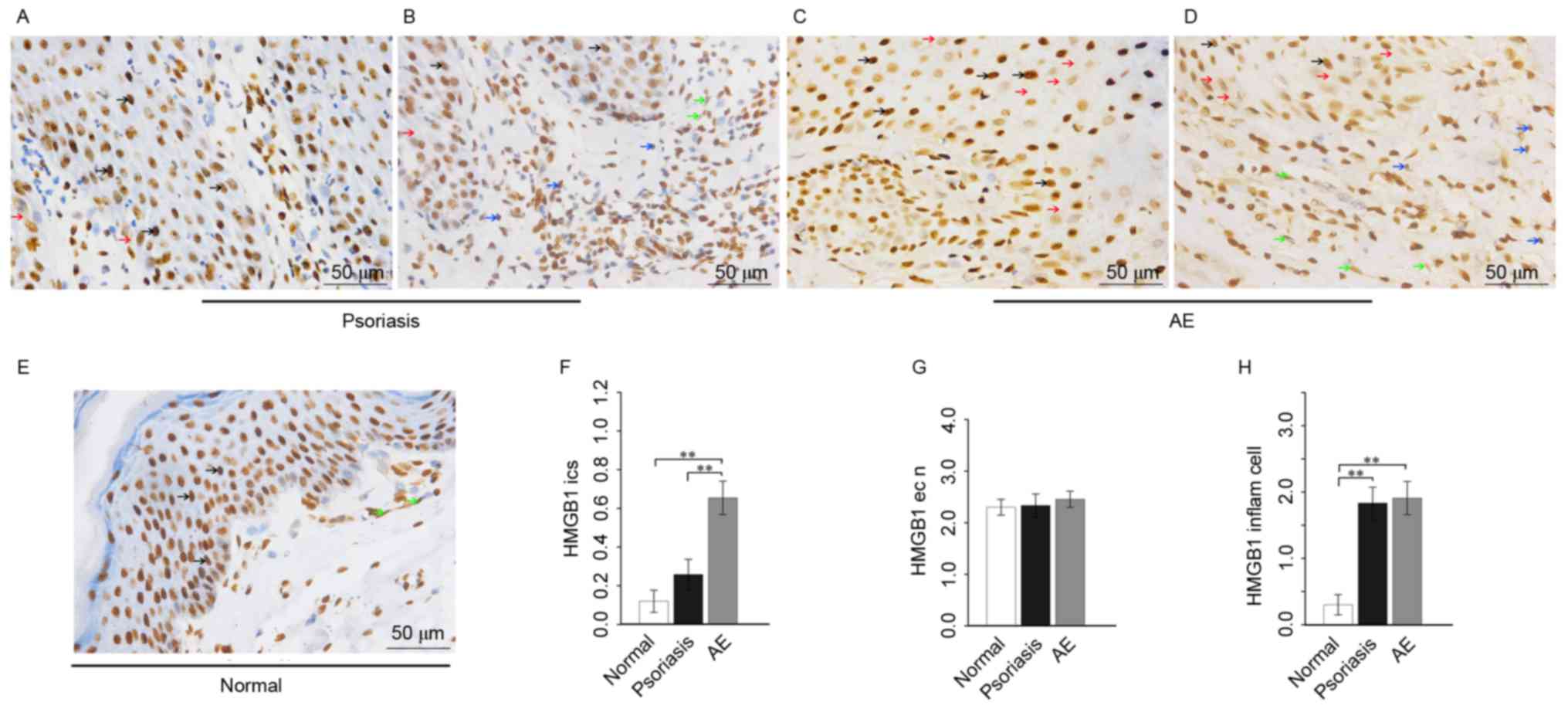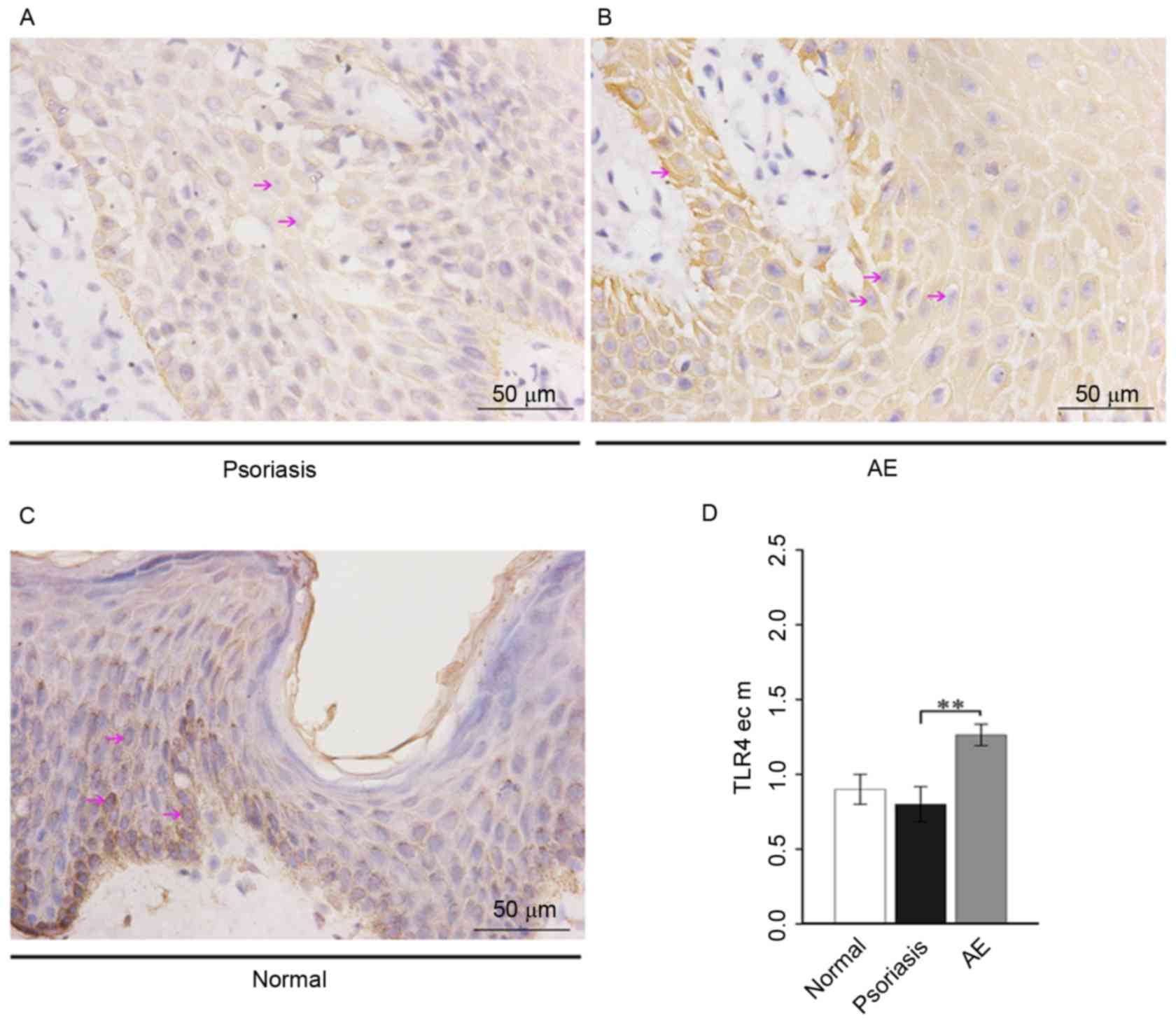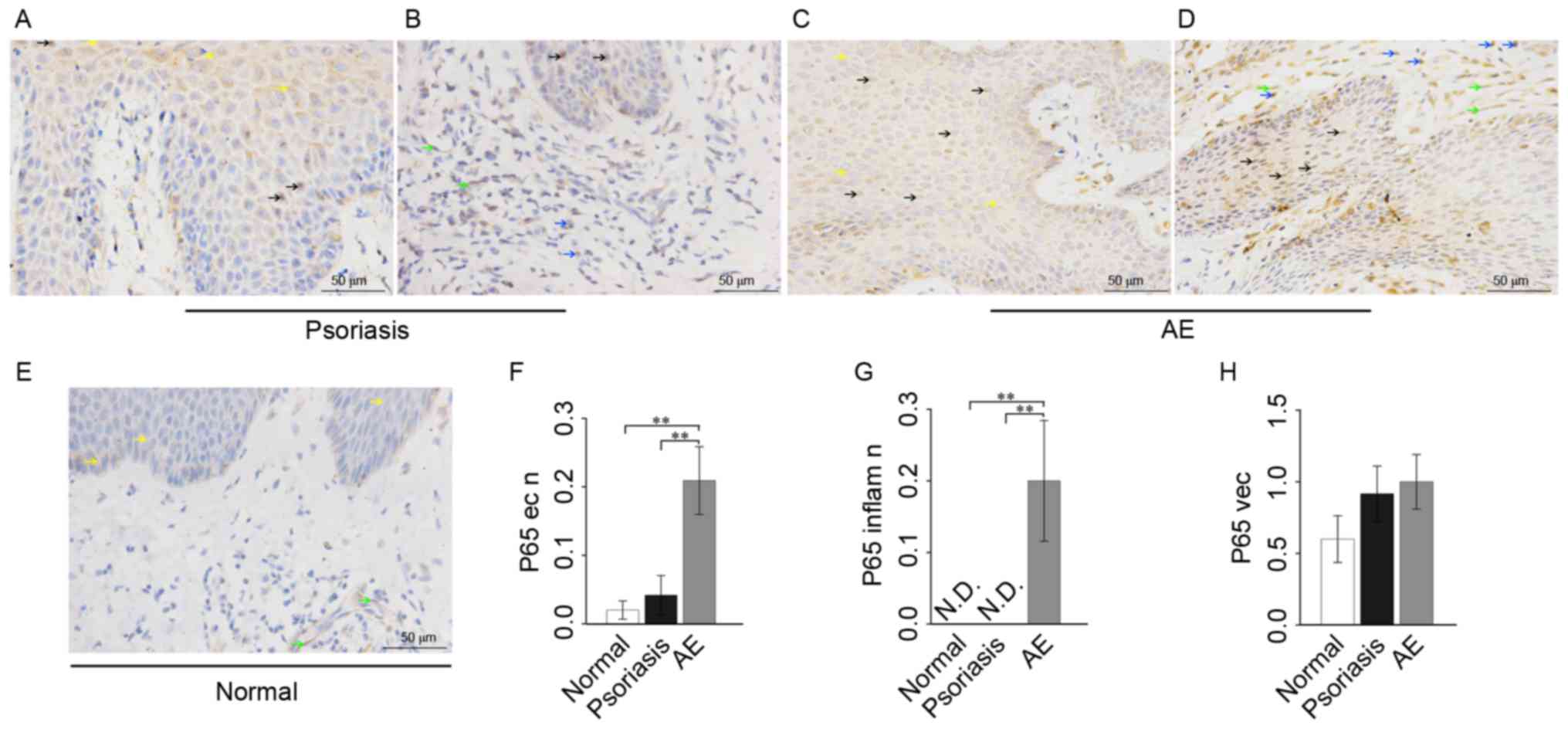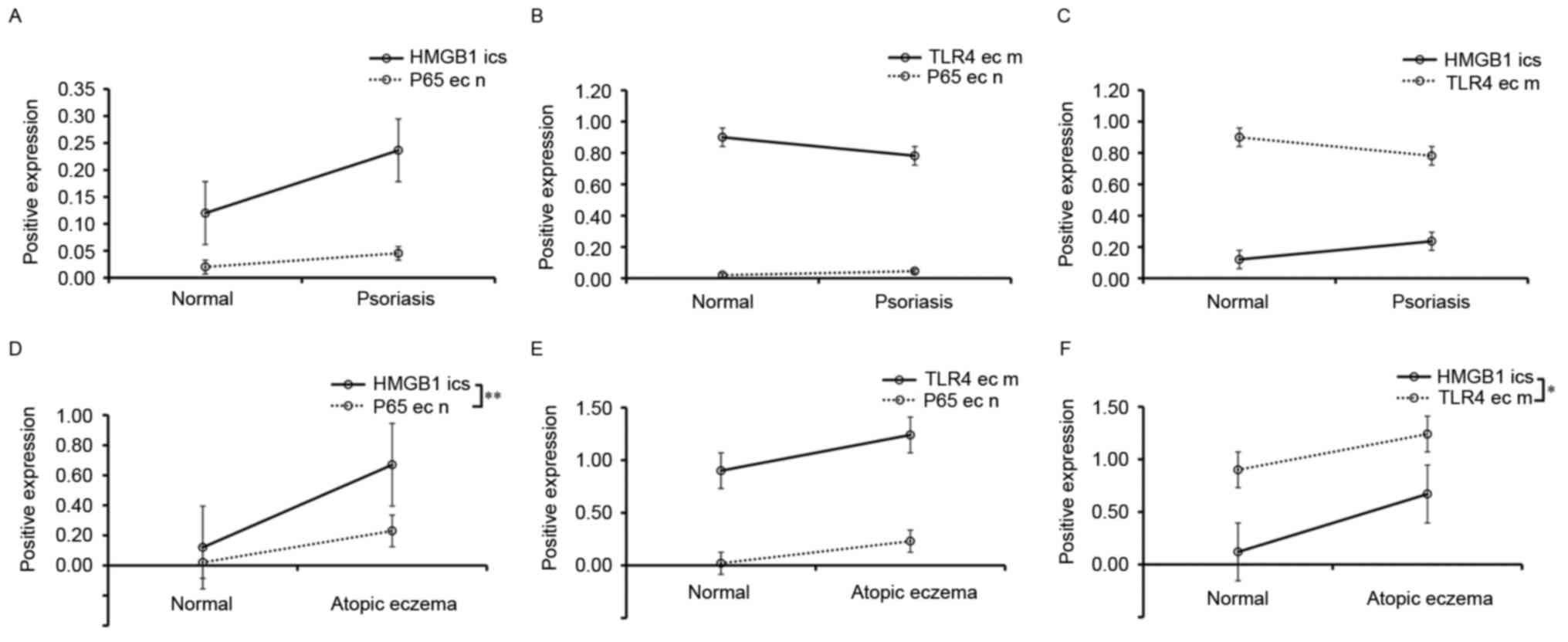|
1
|
Hanifin JM: Evolving concepts of
pathogenesis in atopic dermatitis and other eczemas. J Invest
Dermatol. 129:320–322. 2009. View Article : Google Scholar : PubMed/NCBI
|
|
2
|
Werfel T, Breuer K, Ruéff F, Przybilla B,
Worm M, Grewe M, Ruzicka T, Brehler R, Wolf H, Schnitker J and Kapp
A: Usefulness of specific immunotherapy in patients with atopic
dermatitis and allergic sensitization to house dust mites: A
multi-centre, randomized, dose-response study. Allergy. 61:202–205.
2006. View Article : Google Scholar : PubMed/NCBI
|
|
3
|
Lowes MA, Bowcock AM and Krueger JG:
Pathogenesis and therapy of psoriasis. Nature. 445:866–873. 2007.
View Article : Google Scholar : PubMed/NCBI
|
|
4
|
Lew W, Bowcock AM and Krueger JG:
Psoriasis vulgaris: Cutaneous lymphoid tissue supports T-cell
activation and ‘Type 1’ inflammatory gene expression. Trends
Immunol. 25:295–305. 2004. View Article : Google Scholar : PubMed/NCBI
|
|
5
|
Boyman O, Conrad C, Tonel G, Gilliet M and
Nestle FO: The pathogenic role of tissue-resident immune cells in
psoriasis. Trends Immunol. 28:51–57. 2007. View Article : Google Scholar : PubMed/NCBI
|
|
6
|
Griffiths CE and Barker JN: Pathogenesis
and clinical features of psoriasis. Lancet. 370:263–271. 2007.
View Article : Google Scholar : PubMed/NCBI
|
|
7
|
Boniface K, Guignouard E, Pedretti N,
Garcia M, Delwail A, Bernard FX, Nau F, Guillet G, Dagregorio G,
Yssel H, et al: A role for T cell-derived interleukin 22 in
psoriatic skin inflammation. Clin Exp Immunol. 150:407–415. 2007.
View Article : Google Scholar : PubMed/NCBI
|
|
8
|
Takahashi H, Tsuji H, Hashimoto Y,
Ishida-Yamamoto A and Iizuka H: Serum cytokines and growth factor
levels in Japanese patients with psoriasis. Clin Exp Dermatol.
35:645–649. 2010. View Article : Google Scholar : PubMed/NCBI
|
|
9
|
Kasraie S and Werfel T: Role of
macrophages in the pathogenesis of atopic dermatitis. Mediators
Inflamm. 2013:9423752013. View Article : Google Scholar : PubMed/NCBI
|
|
10
|
Valledor AF, Comalada M, Santamaria-Babi
LF, Lloberas J and Celada A: Macrophage proinflammatory activation
and deactivation: A question of balance. Adv Immunol. 108:1–20.
2010. View Article : Google Scholar : PubMed/NCBI
|
|
11
|
Dai S, Sodhi C, Cetin S, Richardson W,
Branca M, Neal MD, Prindle T, Ma C, Shapiro RA, Li B, et al:
Extracellular high mobility group box-1 (HMGB1) inhibits enterocyte
migration via activation of Toll-like receptor-4 and increased
cell-matrix adhesiveness. J Biol Chem. 285:4995–5002. 2010.
View Article : Google Scholar : PubMed/NCBI
|
|
12
|
Pisetsky D: Cell death in the pathogenesis
of immune-mediated diseases: The role of HMGB1 and DAMP-PAMP
complexes. Swiss Med Wkly. 141:w132562011.PubMed/NCBI
|
|
13
|
Tadie JM, Bae HB, Deshane JS, Bell CP,
Lazarowski ER, Chaplin DD, Thannickal VJ, Abraham E and Zmijewski
JW: Toll-like receptor 4 engagement inhibits adenosine
5′-monophosphate-activated protein kinase activation through a high
mobility group box 1 protein-dependent mechanism. Mol Med.
18:659–668. 2012. View Article : Google Scholar : PubMed/NCBI
|
|
14
|
Oh H and Ghosh S: NF-κB: Roles and
regulation in different CD4(+) T-cell subsets. Immunol Rev.
252:41–51. 2013. View Article : Google Scholar : PubMed/NCBI
|
|
15
|
Harris HE, Andersson U and Pisetsky DS:
HMGB1: A multifunctional alarmin driving autoimmune and
inflammatory disease. Nat Rev Rheumatol. 8:195–202. 2012.
View Article : Google Scholar : PubMed/NCBI
|
|
16
|
Weng H, Deng Y, Xie Y, Liu H and Gong F:
Expression and significance of HMGB1, TLR4 and NF-κB p65 in human
epidermal tumors. Bmc Cancer. 13:3112013. View Article : Google Scholar : PubMed/NCBI
|
|
17
|
Chen T, Guo ZP, Li L, Wang L, Jia RZ, Cao
N, Qin S and Li MM: Increased HMGB1 serum levels and altered HMGB1
expression in patients with psoriasis vulgaris. Arch Dermatol Res.
305:263–267. 2013. View Article : Google Scholar : PubMed/NCBI
|
|
18
|
Nakajima S, Watanabe H, Tohyama M, Sugita
K, Iijima M, Hashimoto K, Tokura Y, Nishimura Y, Doi H, Tanioka M,
et al: High-mobility group box 1 protein (HMGB1) as a novel
diagnostic tool for toxic epidermal necrolysis and Stevens-Johnson
syndrome. Arch Dermatol. 147:1110–1112. 2011. View Article : Google Scholar : PubMed/NCBI
|
|
19
|
Oranje AP, Glazenburg EJ, Wolkerstorfer A
and de Waard-van der Spek FB: Practical issues on interpretation of
scoring atopic dermatitis: The SCORAD index, objective SCORAD and
the three-item severity score. Br J Dermatol. 157:645–648. 2007.
View Article : Google Scholar : PubMed/NCBI
|
|
20
|
Langley RG and Ellis CN: Evaluating
psoriasis with psoriasis area and severity index, psoriasis global
assessment, and lattice system physician's global assessment. J Am
Acad Dermatol. 51:563–569. 2004. View Article : Google Scholar : PubMed/NCBI
|
|
21
|
Verma IM, Stevenson JK, Schwarz EM, Van
Antwerp D and Miyamoto S: Rel/NF-kappa B/I kappa B family: Intimate
tales of association and dissociation. Genes Dev. 9:2723–2735.
1995. View Article : Google Scholar : PubMed/NCBI
|
|
22
|
Ghosh S, May MJ and Kopp EB: NF-kappa B
and Rel proteins: Evolutionarily conserved mediators of immune
responses. Annu Rev Immunol. 16:225–260. 1998. View Article : Google Scholar : PubMed/NCBI
|
|
23
|
Li Q and Verma IM: NF-kappaB regulation in
the immune system. Nat Rev Immunol. 2:725–734. 2002. View Article : Google Scholar : PubMed/NCBI
|
|
24
|
Mayo MW and Baldwin AS: The transcription
factor NF-kappaB: Control of oncogenesis and cancer therapy
resistance. Biochim Biophys Acta. 1470:M55–M62. 2000.PubMed/NCBI
|
|
25
|
Lin A and Karin M: NF-kappaB in cancer: A
marked target. Semin Cancer Biol. 13:107–114. 2003. View Article : Google Scholar : PubMed/NCBI
|
|
26
|
Karuppagounder V, Arumugam S,
Thandavarayan RA, Pitchaimani V, Sreedhar R, Afrin R, Harima M,
Suzuki H, Nomoto M, Miyashita S, et al: Modulation of HMGB1
translocation and RAGE/NFκB cascade by quercetin treatment
mitigates atopic dermatitis in NC/Nga transgenic mice. Exp
Dermatol. 24:418–423. 2015. View Article : Google Scholar : PubMed/NCBI
|
|
27
|
Lee HK, Kim HS, Kim YJ, Kim JS, Park YS,
Kang JS, Yuk DY, Hong JT, Kim Y and Han SB: Sophoricoside isolated
from Sophora japonica ameliorates contact dermatitis by
inhibiting NF-κB signaling in B cells. Int Immunopharmacol.
15:467–473. 2013. View Article : Google Scholar : PubMed/NCBI
|
|
28
|
Kim JH, Kim MH, Yang G, Huh Y, Kim SH and
Yang WM: Effects of topical application of Astragalus membranaceus
on allergic dermatitis. Immunopharmacol Immunotoxicol. 35:151–156.
2013. View Article : Google Scholar : PubMed/NCBI
|
|
29
|
Goldminz AM, Au SC, Kim N, Gottlieb AB and
Lizzul PF: NF-κB: An essential transcription factor in psoriasis. J
Dermatol Sci. 69:89–94. 2013. View Article : Google Scholar : PubMed/NCBI
|
|
30
|
Yan S, Xu Z, Lou F, Zhang L, Ke F, Bai J,
Liu Z, Liu J, Wang H, Zhu H, et al: NF-κB-induced microRNA-31
promotes epidermal hyperplasia by repressing protein phosphatase 6
in psoriasis. Nat Commun. 6:76522015. View Article : Google Scholar : PubMed/NCBI
|
|
31
|
Andrés RM, Montesinos MC, Navalón P, Payá
M and Terencio MC: NF-κB and STAT3 inhibition as a therapeutic
strategy in psoriasis: In vitro and in vivo effects of BTH. J
Invest Dermatol. 133:2362–2371. 2013. View Article : Google Scholar : PubMed/NCBI
|
|
32
|
Kaisho T and Akira S: Toll-like receptor
function and signaling. J Allergy Clin Immunol. 117:979–987; quiz
988. 2006. View Article : Google Scholar : PubMed/NCBI
|
|
33
|
Park JS, Gamboni-Robertson F, He Q,
Svetkauskaite D, Kim JY, Strassheim D, Sohn JW, Yamada S, Maruyama
I, Banerjee A, et al: High mobility group box 1 protein interacts
with multiple Toll-like receptors. Am J Physiol Cell Physiol.
290:C917–C924. 2006. View Article : Google Scholar : PubMed/NCBI
|
|
34
|
Nair AR, Ebenezer PJ, Saini Y and Francis
J: Angiotensin II-induced hypertensive renal inflammation is
mediated through HMGB1-TLR4 signaling in rat tubulo-epithelial
cells. Exp Cell Res. 335:238–247. 2015. View Article : Google Scholar : PubMed/NCBI
|
|
35
|
Wang FC, Pei JX, Zhu J, Zhou NJ, Liu DS,
Xiong HF, Liu XQ, Lin DJ and Xie Y: Overexpression of HMGB1 A-box
reduced lipopolysaccharide-induced intestinal inflammation via
HMGB1/TLR4 signaling in vitro. World J Gastroenterol. 21:7764–7776.
2015. View Article : Google Scholar : PubMed/NCBI
|
|
36
|
Yang Z, Deng Y, Su D, Tian J, Gao Y, He Z
and Wang X: TLR4 as receptor for HMGB1-mediated acute lung injury
after liver ischemia/reperfusion injury. Lab Invest. 93:792–800.
2013. View Article : Google Scholar : PubMed/NCBI
|
|
37
|
Panzer R, Blobel C, Fölster-Holst R and
Proksch E: TLR2 and TLR4 expression in atopic dermatitis, contact
dermatitis and psoriasis. Exp Dermatol. 23:364–366. 2014.
View Article : Google Scholar : PubMed/NCBI
|


















